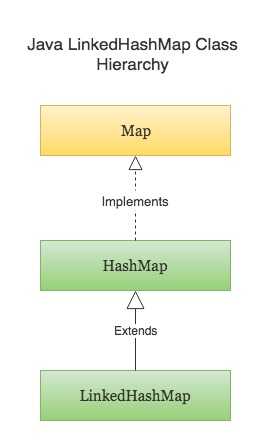Java LinkedHashMap is a hash table and doubly linked List based implementation of Java’s Map interface. It extends the HashMap class which is another very commonly used implementation of the Map interface -
The HashMap class doesn’t guarantee any specific iteration order of the elements. It doesn’t keep track of the order in which the elements are inserted, and produces the elements in a random order every time you iterate over it.
If you want a predictable iteration order of the elements in a Map, then you can use a LinkedHashMap.
The iteration order in a LinkedHashMap is normally the order in which the elements are inserted. However, it also provides a special constructor using which you can change the iteration order from the least-recently accessed element to the most-recently accessed element and vice versa. This kind of iteration order can be useful in building LRU caches. In any case, the iteration order is predictable.
Following are some important points to note about LinkedHashMap in Java -
A LinkedHashMap cannot contain duplicate keys.
LinkedHashMap can have
nullvalues and thenullkey.Unlike HashMap, the iteration order of the elements in a LinkedHashMap is predictable.
Just like HashMap, LinkedHashMap is not thread-safe. You must explicitly synchronize concurrent access to a LinkedHashMap in a multi-threaded environment.
Creating and Initializing a LinkedHashMap
The following example shows how to create a LinkedHashMap and add new key-value pairs to it.
import java.util.LinkedHashMap;
public class CreateLinkedHashMapExample {
public static void main(String[] args) {
// Creating a LinkedHashMap
LinkedHashMap<String, Integer> wordNumberMapping = new LinkedHashMap<>();
// Adding new key-value pairs to the LinkedHashMap
wordNumberMapping.put("one", 1);
wordNumberMapping.put("two", 2);
wordNumberMapping.put("three", 3);
wordNumberMapping.put("four", 4);
// Add a new key-value pair only if the key does not exist in the LinkedHashMap, or is mapped to `null`
wordNumberMapping.putIfAbsent("five", 5);
System.out.println(wordNumberMapping);
}
}# Output
{one=1, two=2, three=3, four=4, five=5}Accessing the entries of a LinkedHashMap
This example shows how to
- Check if a key exists in a LinkedHashMap.
- Check if a value exists in the LinkedHashMap.
- Modify the value associated with a given key in the LinkedHashMap.
import java.util.LinkedHashMap;
public class AccessEntriesFromLinkedHashMapExample {
public static void main(String[] args) {
LinkedHashMap<Integer, String> customerIdNameMapping = new LinkedHashMap<>();
customerIdNameMapping.put(1001, "Jack");
customerIdNameMapping.put(1002, "David");
customerIdNameMapping.put(1003, "Steve");
customerIdNameMapping.put(1004, "Alice");
customerIdNameMapping.put(1005, "Marie");
System.out.println("customerIdNameMapping : " + customerIdNameMapping);
// Check if a key exists in the LinkedHashMap
Integer id = 1005;
if(customerIdNameMapping.containsKey(id)) {
System.out.println("Found the customer with id " + id + " : " + customerIdNameMapping.get(id));
} else {
System.out.println("Customer with id " + id + " does not exist");
}
// Check if a value exists in the LinkedHashMap
String name = "David";
if(customerIdNameMapping.containsValue(name)) {
System.out.println("A customer named " + name + " exist in the map");
} else {
System.out.println("No customer found with name " + name + " in the map");
}
// Change the value associated with an existing key
id = 1004;
customerIdNameMapping.put(id, "Bob");
System.out.println("Changed the name of customer with id " + id + ", New mapping : " + customerIdNameMapping);
}
}# Output
customerIdNameMapping : {1001=Jack, 1002=David, 1003=Steve, 1004=Alice, 1005=Marie}
Found the customer with id 1005 : Marie
A customer named David exist in the map
Changed the name of customer with id 1004, New mapping : {1001=Jack, 1002=David, 1003=Steve, 1004=Bob, 1005=Marie}Removing entries from a LinkedHashMap
The example below shows how to
- Remove a key from a LinkedHashMap.
- Remove a key from a LinkedHashMap only if it is associated with the given value.
import java.util.LinkedHashMap;
public class RemoveEntriesFromLinkedHashMapExample {
public static void main(String[] args) {
LinkedHashMap<String, String> husbandWifeMapping = new LinkedHashMap<>();
husbandWifeMapping.put("Rajeev", "Jennifer");
husbandWifeMapping.put("John", "Maria");
husbandWifeMapping.put("Chris", "Lisa");
husbandWifeMapping.put("Steve", "Susan");
System.out.println("husbandWifeMapping : " + husbandWifeMapping);
// Remove a key from the LinkedHashMap
String wife = husbandWifeMapping.remove("John");
System.out.println("Removed John and his wife " + wife + " from the mapping. New husbandWifeMapping : " + husbandWifeMapping);
// Remove a key from the LinkedHashMap only if it is mapped to the given value
boolean isRemoved = husbandWifeMapping.remove("John", "Susan");
System.out.println("Did John get removed from the mapping? : " + isRemoved);
}
}# Output
husbandWifeMapping : {Rajeev=Jennifer, John=Maria, Chris=Lisa, Steve=Susan}
Removed John and his wife Maria from the mapping. New husbandWifeMapping : {Rajeev=Jennifer, Chris=Lisa, Steve=Susan}
Did John get removed from the mapping? : falseIterating over a LinkedHashMap
The example in this section shows various ways of iterating over a LinkedHashMap:
- Iterate over a LinkedHashMap using Java 8 forEach and lambda expression.
- Iterate over a LinkedHashMap’s entrySet using Java 8 forEach and lambda expression.
- Iterate over a LinkedHashMap’s entrySet using iterator().
- Iterate over a LinkedHashMap’s entrySet using iterator() and Java 8 forEachRemaining() method.
import java.util.Iterator;
import java.util.LinkedHashMap;
import java.util.Map;
public class IterateOverLinkedHashMapExample {
public static void main(String[] args) {
LinkedHashMap<String, String> userCityMapping = new LinkedHashMap<>();
userCityMapping.put("Rajeev", "Bengaluru");
userCityMapping.put("Chris", "London");
userCityMapping.put("David", "Paris");
userCityMapping.put("Jesse", "California");
System.out.println("=== Iterating over a LinkedHashMap using Java 8 forEach and lambda ===");
userCityMapping.forEach((user, city) -> {
System.out.println(user + " => " + city);
});
System.out.println("\n=== Iterating over the LinkedHashMap's entrySet using Java 8 forEach and lambda ===");
userCityMapping.entrySet().forEach(entry -> {
System.out.println(entry.getKey() + " => " + entry.getValue());
});
System.out.println("\n=== Iterating over the entrySet of a LinkedHashMap using iterator() ===");
Iterator<Map.Entry<String, String>> userCityMappingIterator = userCityMapping.entrySet().iterator();
while (userCityMappingIterator.hasNext()) {
Map.Entry<String, String> entry = userCityMappingIterator.next();
System.out.println(entry.getKey() + " => " + entry.getValue());
}
System.out.println("\n=== Iterating over the entrySet of a LinkedHashMap using iterator() and forEachRemaining ===");
userCityMappingIterator = userCityMapping.entrySet().iterator();
userCityMappingIterator.forEachRemaining(entry -> {
System.out.println(entry.getKey() + " => " + entry.getValue());
});
}
}# Output
=== Iterating over a LinkedHashMap using Java 8 forEach and lambda ===
Rajeev => Bengaluru
Chris => London
David => Paris
Jesse => California
=== Iterating over the LinkedHashMap's entrySet using Java 8 forEach and lambda ===
Rajeev => Bengaluru
Chris => London
David => Paris
Jesse => California
=== Iterating over the entrySet of a LinkedHashMap using iterator() ===
Rajeev => Bengaluru
Chris => London
David => Paris
Jesse => California
=== Iterating over the entrySet of a LinkedHashMap using iterator() and forEachRemaining ===
Rajeev => Bengaluru
Chris => London
David => Paris
Jesse => CaliforniaConclusion
Congratulations folks! In this article, you learned what is a LinkedHashMap, how to create a LinkedHashMap, how to add new key-value pairs to a LinkedHashMap, how to remove entries from a LinkedHashMap, and how to iterate over a LinkedHashMap.
Thank you for reading. See you in the next post.

